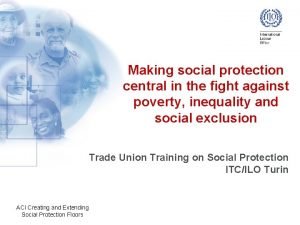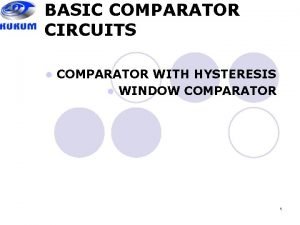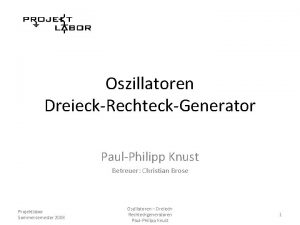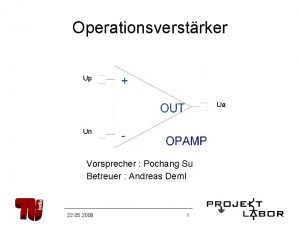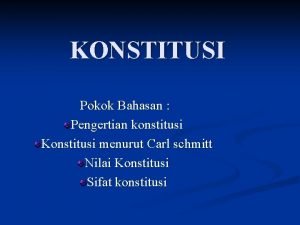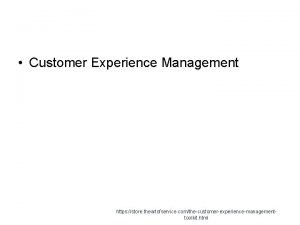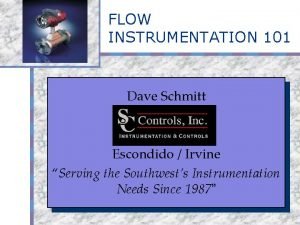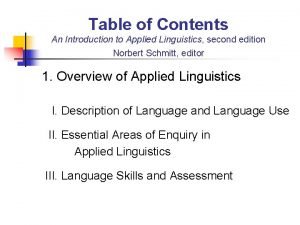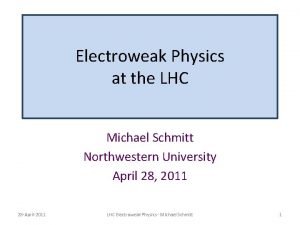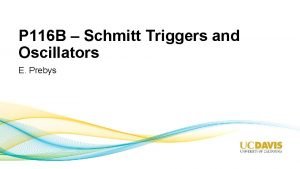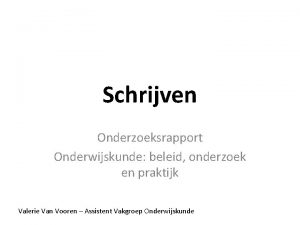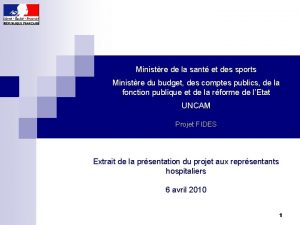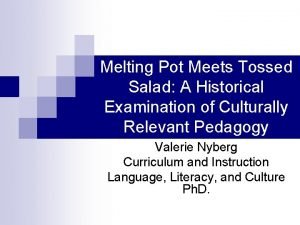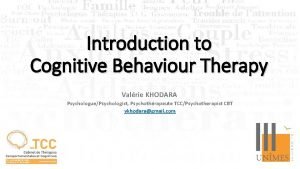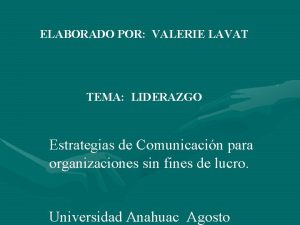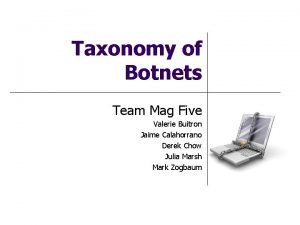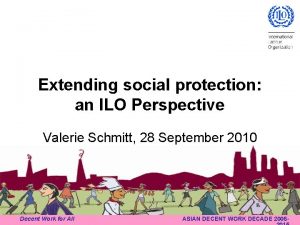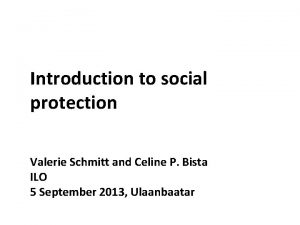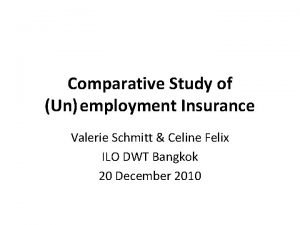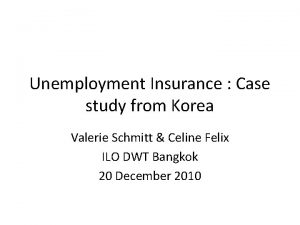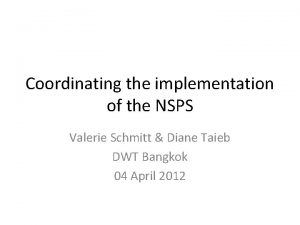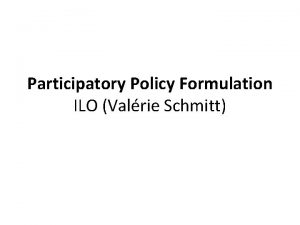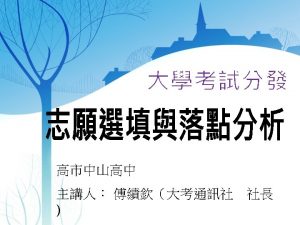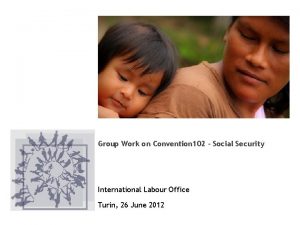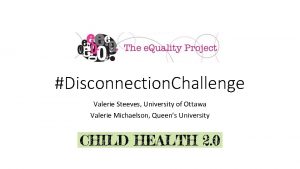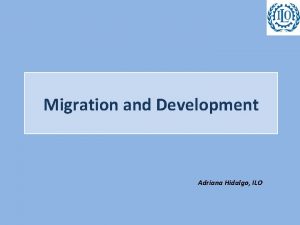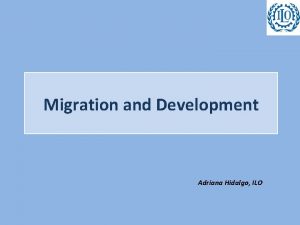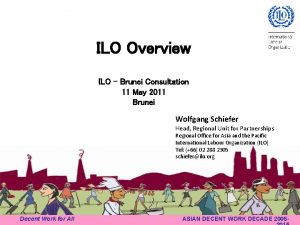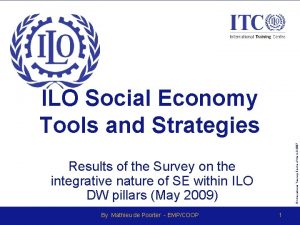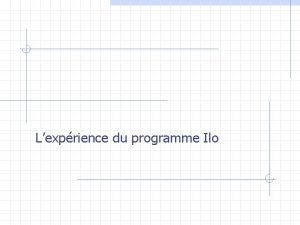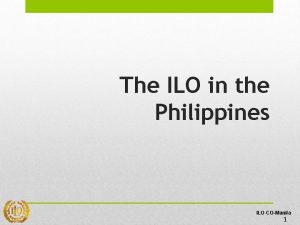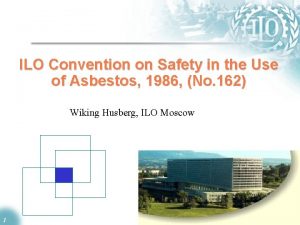ILO Convention 102 on Social security Valerie Schmitt


























- Slides: 26

ILO Convention 102 on Social security Valerie Schmitt, ILO DWT Bangkok Experts meeting in Jakarta 12 -15 December 2011

ILO Convention 102 on Social security • Agenda: – What is Convention 102? – How to ratify C 102? – The upcoming recommendation on the SPF – R 202

Convention 102 built on the ideas that: • There is no right model for social security • Social security grows and evolves over time • Social security policies should reflect countries’ social and cultural values, their history, their institutions and their level of economic development

Main features of Convention 102 • Adopted by the ILC 1952 • Tool (guideline) for the design and implementation of social security law – Comprehensive definition of social security (nine branches) – Minimum standards for each branch – Flexibility clauses step by step extension of social security coverage by ratifying country – Principles

Main features of Convention 102 • Nine branches: 1. Access to medical care 2. Sickness 3. Unemployment 4. Old age benefit 5. Employment injury 6. Family benefit 7. Maternity benefit 8. Invalidity benefit 9. Survivor’s benefit

Main features of Convention 102 • Minimum standards are set for each contingency : – minimum level of benefits to be paid – percentage of the population to be at least protected (in percentage of employees or in percentage of residents i. e. including formal sector employees, self employed, etc. ) – conditions for entitlement to benefits – duration of benefit

Main features of Convention 102 • Minimum standards for each contingency Minimu m Standards Branches Benefit Conditions Duration of Coverage of persons Benefit Sickness Benefit 45 % To preclude abuse 26 weeks (each case 50% of all employees or 20% of all residents, or all sickness) Unemployment Benefit Old-Age Benefit 45 % To preclude abuse 13 weeks in period of 50% of all employees, or all residents whose means do 12 months not exceed certain limits 40 % 30 years Throughout the 50% of all employees or 20% of all residents, or all residents whose means do not exceed certain limits contingency Employment Injury Benefits Short term disability 50 % No qualifying Throughout the contingency Permanent disability 50 % period allowed Death of the breadwinner 40% Family Benefit residents whose means do not exceed certain limits 3% or 1, 5% To preclude abuse Throughout the contingency 50% of all employees, and their widows and children in case of death of the breadwinner through an employment injury 50% of all employees or 20% of all residents, or all residents whose means do not exceed certain limits Maternity Benefit 45 % To preclude abuse Minimum of 12 weeks Women of classes of employees constituting not less than 50% of all employees or 20% of all residents, Invalidity Benefit 40 % 15 years Throughout the Survivors’ Benefit contingency or until old – age pension is paid 40 % 15 years Throughout the 50% of all employees or 20% of all residents, or all residents whose means do not exceed certain limits Wives and children of 50% of all employees, or 20% of all residents, or all resident wives and children whose

Main features of Convention 102 • Flexibility clauses allow ratifying country to gradually extend coverage… • A State can choose to protect (article 9): • • At least 50% employees + Spouse & • At least 20% Economically active population children • At least 20% residents A State can ratify with 3 branches only including at least one among : unemployment, old age, employment injury, invalidity and survivors • Scheme can be: universal, social insurance, social assistance • Administration can be: public or private

Main features of Convention 102 • Principles The State is responsible for the provision of benefits & proper functioning of the scheme Solidarity & pooling of risks • between men & women, rich & poor, generations Tripartite administration • Representatives of covered persons must participate in the management or associated to the key decisions Collective financing of benefits • Through contributions, taxation or both • Employees’ contributions should not exceed 50% of the financial resources allocated

Main features of Convention 102 • Principles (continued) Adjustment of pensions (to keep the purchasing power) • Following changes in the cost of living or general level of earnings Right to appeal • In case of the refusal of the benefit • Regarding the quality & quantity of benefits Suspension of benefits • If beneficiary absent from territory, receives other benefits, made a fraudulent claim …

The need for a recommendation on the Social Protection Floor • All the principles of the Convention 102 apply when we decide to build a social protection floor • However Convention 102 does not include the principle of Universality which is included under the definition of the Social Protection Floor

ILO Convention 102 on Social security • Agenda: – What is Convention 102? – How to ratify C 102? – The upcoming recommendation on the SPF – R 202

47 countries have ratified C 102 Brazil, Romania, 2009 Uruguay, 2010 Japan Sweden

What is the ratification process? SIGN THE CONVENTION Promise to adhere to principles & norms of C 102 SUBMISSION TO PARLIAMENT Comparison C 102 & National Law and Practice Conformity PARLIAMENT AUTHORIZES RATIFICATION & COMPLIANCE Non conformity AMEND LAW & MODIFY PRACTICE

Why is it important to ratify C 102? • Benefit from ILO experience & technical assistance (policy advice, actuarial studies, …) • Guarantee for well established SS system • Enhances confidence in the SS system • Prevents from slipping back • Contributes to extension of coverage and poverty reduction

ILO Convention 102 on Social security • Agenda: – What is Convention 102? – How to ratify C 102? – The upcoming recommendation on the SPF – R 202

The need for a recommendation on the Social Protection Floor • All the principles of the Convention 102 apply when we decide to build a social protection floor • However Convention 102 does not include the principle of Universality which is included under the definition of the Social Protection Floor • Entitlement and levels of benefits related to passed income

Procedure of development • • Report VI – Green report Recurrent discussion at ILC 2011 Resolution and conclusions Report IV (1) – White report & Questionnaire sent to all member States • Based on the answers to the Questionnaire, Blue report • Discussion at ILC 2012, possible adoption of Recommendation 202 18

Procedure of development Ques tionna ire pleas e subm it b efor 1 Nov e 2011 19

Report VI : a basis for the Recurrent Discussion on Social Protection • Report VI, Social security for social justice and a fair globalization • Available on ILC website and GESS platform • In English, French, Spanish, Arabic, Chinese, German and Russian 20

Report VI : a basis for the Recurrent Discussion on Social Protection • Report VI, Social security for social justice and a fair globalization • Definition of SS, right to SS and need for SS • Description of Social security situation in the world • Challenges / recommendations: SS policy should be coherent with national devlt frameworks, socially adequate (minimum benchmarks), well managed, affordable & sustainable, fiscal space should be increased, coverage should extended • Suggestions for future ILO work : standards promotion, support to implementation of SS staircase, knowledge sharing, capacity building and … development of a new standard on SPF 21

Resolution and conclusions of the recurrent discussion, adopted at the ILC 2011 (183 member states) 22

Resolution and conclusions of the recurrent discussion • Endorses ILO two-dimensional strategy for the extension of social security coverage • Concludes the need for the ILO to formulate a new Recommendation on social protection floors • Reaffirms ILO’s mandate to assist member States in: • Designing and implementing the two-dimensional extension strategy, including SPF • Promoting and implementing ILO SS standards • Facilitating exchange of experiences and good practices 23

Answering the questionnaire • Was sent to all member states and we sent reminders to countries in East Asia, South East Asia and the Pacific • Questions are closed (YES/NO) • Important that all Line Ministries involved in Social Security & the SPF participate in providing answers to the questionnaire : Mo. L, Mo. H, Mo. SAVY, Mo. Finance, Mo. Agriculture, CARD, etc. as well as Social Partners 24 • Deadline: 1 Nov 2011

Elements of a possible recommendation on SPF • 8 key principles of possible recommendation 1. Ultimate objective = adequate social protection for all across the life cycle 2. Progressive implementation 3. Linkages with employment & other national devlt frameworks (not isolated island) 4. Combining objectives of poverty reduction, protecting against social risks and empowerment of people 5. Sound financing & financial management practices 6. National legislation describing guarantees and benefits ( benefit reliability, predictability, indexation… ) 7. Robust & transparent governance 8. Particular attention to gender responsive approaches 25

Elements of a possible recommendation on SPF • Elements that cannot be prescribed (responsibility of member states) 1. Range and types of benefits 2. Organizational set up 3. Type of mechanisms (universal benefits, insurance based, targeted, conditional or not …) 4. Levels of benefits related to national circumstances: level and distribution of income in the country, availability of health infrastructures, dimension of fiscal space… 26
 Private securty
Private securty Ilo social protection
Ilo social protection Non inverting schmitt trigger
Non inverting schmitt trigger Configurazioni amplificatore operazionale
Configurazioni amplificatore operazionale Rechteckgenerator schmitt trigger
Rechteckgenerator schmitt trigger Mitkopplung
Mitkopplung Konstitusi menurut carl schmitt
Konstitusi menurut carl schmitt Cincom synchrony
Cincom synchrony Schmitt heating and air
Schmitt heating and air An introduction to applied linguistics
An introduction to applied linguistics Newellization
Newellization Lorelei schmitt
Lorelei schmitt Michael schmitt northwestern
Michael schmitt northwestern Julia schmitt finance
Julia schmitt finance Schmitt trigger oscillator op amp
Schmitt trigger oscillator op amp Cerfa 60-3510
Cerfa 60-3510 Convenio 102 de 1952 oit
Convenio 102 de 1952 oit Afnameprotocol machine
Afnameprotocol machine Valérie altuzarra
Valérie altuzarra Valerie nyberg
Valerie nyberg Swift og franzen
Swift og franzen Padesky's 5 aspects model
Padesky's 5 aspects model Valerie lavat
Valerie lavat Valerie brossier
Valerie brossier Valerie buitron
Valerie buitron Machine learning actuary
Machine learning actuary Valerie du preez
Valerie du preez

